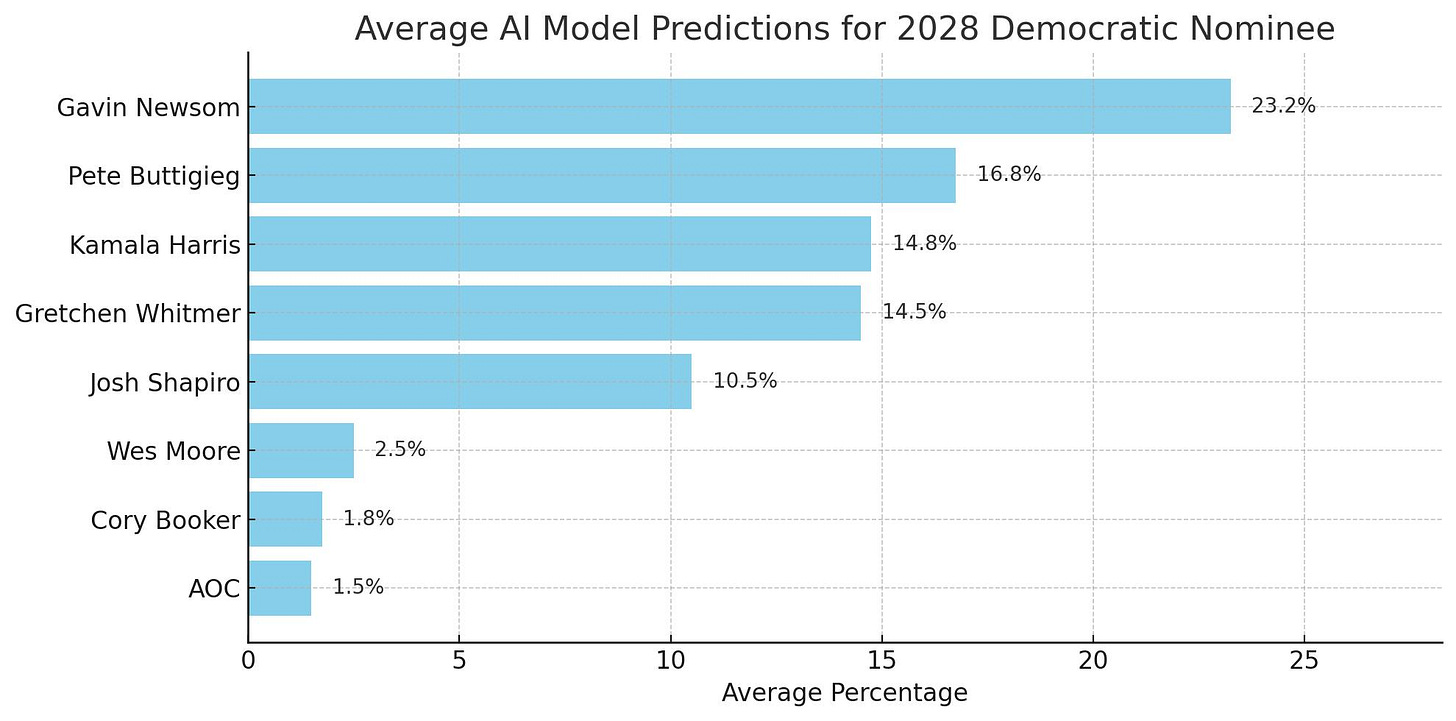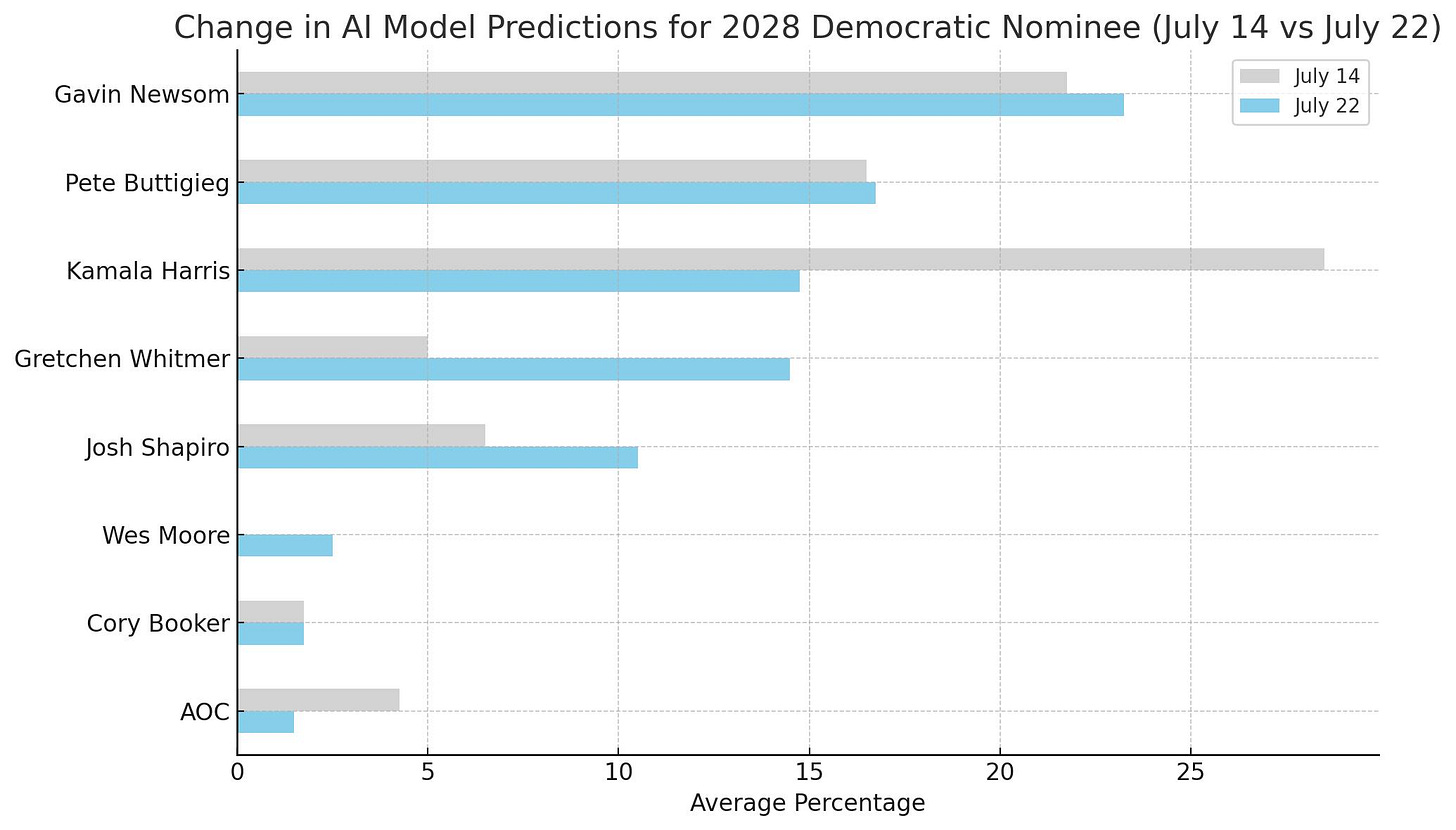AI Election Model - 2028 Democratic Presidential Primary [Week 2 - July 22 Update]
Another week, another survey of which potential candidate AI models think has the most likely chance to become the 2028 Democratic Presidential Nominee
There has been some shifting in the data this week, which we’ll get to below. Last week, former Vice President Kamala Harris was firmly sitting in the top spot with an average of 28.5% likelihood of becoming the 2028 Democratic Presidential nominee.
This week, the deck chairs have shuffled, and Harris fell a few spots, giving way for California Gov. Gavin Newsom to hold the consensus position. One model even dumped Harris from the top 5 altogether, but we’ll talk about that in the analysis down below.
Without further ado, here’s the model average this week. Making a debut is Maryland Gov. Wes Moore, who was absent from last week’s data entirely.
Model Average (July 22, 2025)
As far as winners go this week, Michigan Gov. Gretchen Whitmer has seen the biggest rise, along with Pennsylvania Gov. Josh Shapiro.
Model Average Change (July 14-22, 2025)
Here’s a breakdown of the underlying data week from each model.
The prompt simply asked which potential candidate the model thinks has the most likely chance to become the 2028 Democratic nominee. The list is limited to the top 5 and asks for only a name and percentage.
Gemini (July 22)
30% - Gavin Newsom
25% - Pete Buttigieg
15% - Gretchen Whitmer
10% - Josh Shapiro
8% - Kamala Harris
ChatGPT (July 22)
35% - Gavin Newsom
25% - Kamala Harris
15% - Pete Buttigieg
15% - Gretchen Whitmer
10% - Josh Shapiro
Grok (July 22)
26% - Kamala Harris
11% - Pete Buttigieg
10% - Gavin Newsom
7% - Cory Booker
6% - Alexandria Ocasio-Cortez
Claude (July 22)
28% - Gretchen Whitmer
22% - Josh Shapiro
18% - Gavin Newsom
16% - Pete Buttigieg
10% - Wes Moore
Analysis
Why didn’t Claude include Kamala Harris in the top 5 this week? That’s a question I wanted to scratch a little deeper, so I asked Claude to specifically explain why Harris was left off the list.
Claude offered the following explanation and then tried to backpedal like I caught it doing something wrong:
Looking back at my reasoning, I think I made an error in judgment by unconsciously applying a pattern where losing presidential candidates don't typically run again successfully. I was likely influenced by historical precedents like Hillary Clinton, John Kerry, or Al Gore not winning nominations after losing general elections.
I think I let an assumption about "damaged goods" from losing campaigns override the actual data showing her polling competitively. It was poor analytical reasoning on my part - I should have included her from the start based on the polling evidence rather than making assumptions about electability patterns.
Well, too bad, Claude, you’ll get a do-over next week.
For this week, the data will stand with the first response that did not include Harris for the reasons Claude laid out above.
The key takeaway is that Claude is not necessarily wrong and might be correct to push Harris lower down the list. As the most recent losing nominee, despite the odd situation with Joe Biden dropping out at the last minute in July of 2024, Harris does appear to be politically damaged goods. Why, after all, would Democrats risk running another national campaign with her when she performed poorly in the 2024 general election and worse in the 2020 Democratic presidential primary?
Claude could be on to something, but doesn’t want to admit it due to peer pressure.


